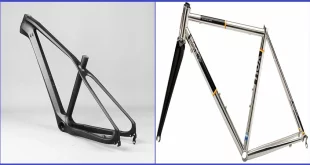Yes, bike frames can be interchangeable as long as they are the same size and have compatible fittings. Introducing this topic, one question that often arises among bike enthusiasts is whether bike frames can be interchangeably used.
The answer to this question is yes, bike frames can indeed be swapped or replaced with other frames, as long as they share the same size and have compatible fittings. This interchangeability allows riders to customize their bikes or replace damaged frames with new ones without the need to purchase an entirely new bike.
However, it is important to note that not all bike frames are interchangeable, as there are variations in frame designs and dimensions among different brands and types of bikes. In this article, we will delve into the topic of bike frame interchangeability, exploring the factors that determine compatibility and providing insights for riders looking to make changes to their bikes.
Understanding Bike Frames
Bike frames play a crucial role in determining the overall performance and functionality of a bicycle. They act as the backbone, connecting all the different components together. Whether you’re considering a road, mountain, or hybrid bike, it’s important to understand the different types of bike frames and their key components.
Let’s dive deeper into the world of bike frames.
Overview Of Different Types Of Bike Frames (Road, Mountain, Hybrid, Etc.)
Road bike frames:
- Designed for speed and efficiency on paved roads.
- Typically made of lightweight materials like aluminum or carbon fiber.
- Features a more aggressive riding position for aerodynamics.
Mountain bike frames:
- Built to withstand rugged terrains and off-road trails.
- Usually constructed with durable materials like steel or aluminum.
- Incorporates features like suspension systems for improved shock absorption.
Hybrid bike frames:
- Combines the best of both road and mountain bikes.
- Suitable for casual commuting and light off-road trails.
- Offers a more relaxed riding position and versatility.
Key Components Of A Bike Frame (Frame Material, Geometry, Size)
Frame material:
- Alloys like aluminum are lightweight, stiff, and affordable.
- Carbon fiber provides increased strength, vibration dampening, and weight reduction.
- Steel offers durability, comfort, and a smooth ride quality.
Frame geometry:
- Refers to the angles and measurements of the bike frame.
- Affects the bike’s handling, stability, and riding characteristics.
- Different geometries suit different riding styles and purposes.
Frame size:
- Determined by the rider’s height, leg inseam, and reach.
- Proper frame size ensures optimal comfort and control.
- Sizing charts and professional fitting can help determine the right frame size.
Relationship Between Bike Frames And Bike Performance
Frame material and performance:
- Lightweight frames allow for faster acceleration and climbing.
- Stiffer frames transfer power more efficiently.
- Dampening qualities of certain frame materials enhance comfort on rough terrain.
Frame geometry and performance:
- Aggressive frame geometry enhances speed and aerodynamics.
- Relaxed frame geometry prioritizes comfort and stability.
- Different frame geometries excel in various riding conditions.
Frame size and performance:
- An ill-fitting frame can result in discomfort and inefficient pedaling.
- The right frame size promotes proper body positioning and efficient power transfer.
- Optimal frame sizing plays a significant role in overall performance.
Understanding the intricacies of bike frames is essential when choosing the right bicycle for your needs. Whether you’re a speed enthusiast, a mountain trail explorer, or a casual rider, the type of frame, its key components, and their relationship to bike performance are all crucial factors to consider.
By selecting the right bike frame, you’ll not only enhance your riding experience but also unlock your cycling potential. Get ready to hit the road or trails with confidence.
Factors Affecting Interchangeability
Compatibility Of Bike Frames With Different Types Of Bikes
When it comes to bike frames, one common question that arises is whether they are interchangeable among different types of bikes. While there may be some cases where interchangeability is possible, it’s important to consider several factors before making any swaps.
Considerations For Interchanging Frames Within The Same Bike Type
If you are thinking about interchanging frames within the same type of bike, such as road bikes or mountain bikes, there are a few key points to keep in mind:
- Frame compatibility: Different bike models may have specific frame requirements, so it’s crucial to ensure compatibility. Factors like bottom bracket type, wheel size, and brake mounting options can affect whether a frame will fit your bike properly.
- Component compatibility: Another consideration is the compatibility of components like drivetrain, derailleurs, and brakes with the new frame. It’s important to check if the components you are currently using can be transferred to the new frame without any issues.
- Frame geometry: Even within the same bike type, frames can vary in terms of geometry, including angles, tube lengths, and stack and reach measurements. Swapping frames with significantly different geometry can affect the handling and feel of your bike, so it’s important to choose a frame that matches your riding preferences.
- Frame sizing: Frame size is a crucial factor to consider when interchanging frames. Different brands and models have their own sizing standards, so it’s essential to ensure that the new frame is compatible with your body measurements and riding style.
The Impact Of Frame Geometry And Sizing On Interchangeability
Frame geometry and sizing play a significant role in the interchangeability of bike frames. Here are a few key points regarding their impact:
- Handling and performance: The geometry of a bike frame influences its handling characteristics, such as stability, responsiveness, and agility. Swapping frames with different geometries can significantly impact the feel and performance of your bike.
- Fit and comfort: Proper frame sizing is crucial for a comfortable and efficient riding experience. Interchanging frames without considering sizing can lead to issues like discomfort, improper weight distribution, and compromised pedaling efficiency.
- Adjustability: Some frames may offer adjustability options for components like seatpost height, stem length, and handlebar position. Interchanging frames that allow for such adjustments can provide more flexibility in achieving your desired riding position.
- Professional advice: When considering interchanging frames, it’s always a good idea to consult with a bike fitting specialist or a professional bike shop. They can provide valuable guidance regarding compatibility, geometry, and sizing, ensuring that you make the right decision for your specific needs.
While bike frame interchangeability is possible in certain cases, it’s crucial to consider the compatibility of frames with different bike types, components, frame geometry, and sizing. Proper research, consultation, and understanding of these factors will help you make informed decisions when it comes to interchanging bike frames.
Interchanging Frames: Pros And Cons
Once you’ve become a bike enthusiast, you may find yourself wondering if you can interchange bike frames. It’s an intriguing concept that offers advantages in terms of versatility and cost-effectiveness. However, there are also limitations and drawbacks to consider, such as performance trade-offs and potential fit issues.
Let’s explore these aspects and delve into some real-life case studies to better understand the world of interchanging bike frames.
Advantages Of Interchanging Bike Frames:
- Versatility: Interchanging frames allows you to customize your bike for various purposes. You can switch between road, mountain, and hybrid frames, adapting to different terrains and riding styles.
- Cost-effectiveness: Rather than purchasing multiple complete bikes, interchanging frames enables you to make the most of your existing components. It can be a budget-friendly option that offers a wide range of cycling experiences.
Limitations And Drawbacks Of Interchanging Bike Frames:
- Performance trade-offs: While interchanging frames increases versatility, it may come at a cost in terms of performance. Different frames have unique characteristics that affect factors such as speed, agility, and stability. Switching frames might not deliver optimal performance for specific scenarios.
- Fit issues: Every rider has unique body proportions and dimensions, and finding the right fit is crucial for comfort and efficiency. Interchanging frames may lead to fit challenges, as not all frames will accommodate every rider’s body geometry.
Case Studies And Examples Of Successful Frame Interchangeability:
- Avid cyclist mark found that by interchanging his frames, he could transform his road bike into a capable gravel grinder. With a few adjustments, he enjoyed the versatility of tackling both paved roads and off-road adventures.
- Professional mountain biker samantha discovered that interchanging frames helped her adapt to different race courses. Switching from a full suspension frame to a hardtail gave her a competitive edge in cross-country races.
Interchanging bike frames can offer exciting possibilities, but it’s essential to consider the pros and cons. While versatility and cost-effectiveness are definite advantages, there are trade-offs in terms of performance and fit. By exploring case studies and examples, we can gain insights into successful frame interchangeability and make informed decisions about our cycling experiences.
How To Determine Interchangeability
When it comes to bike frames, one common question that arises is whether they are interchangeable. Whether you are a bike enthusiast or a casual rider looking to upgrade your bike, understanding the interchangeability of bike frames is crucial. Determining whether a specific bike frame can be swapped with another requires considering various factors such as specifications, measurements, frame materials, dimensions, and compatibility with components.
Here are some key points to keep in mind when evaluating bike frame interchangeability:
Evaluation Of Frame Compatibility Based On Specifications And Measurements:
- Consider the frame type: Bike frames come in different types such as road bikes, mountain bikes, hybrid bikes, and more. Ensuring compatibility between the frame types is essential.
- Look at the frame geometry: Frame geometry affects the overall fit and ride characteristics of a bike. It’s important to compare the geometry of the original frame with the one you intend to interchange to ensure a proper fit.
- Pay attention to frame sizes: Bikes come in various sizes, and it is crucial to match the frame size with your body measurements for a comfortable and efficient ride.
- Check for compatibility with wheel sizes: Different bike frames are designed to accommodate specific wheel sizes. Ensuring the new frame is compatible with your existing wheels is necessary for a smooth riding experience.
Importance Of Considering Frame Materials, Dimensions, And Compatibility With Components:
- Evaluate frame materials: Bike frames can be made from aluminum, carbon fiber, steel, or titanium. Each material offers different characteristics in terms of weight, strength, and ride quality. Consider the material used in the original frame and the one you wish to interchange to determine if it suits your needs.
- Examine frame dimensions: Frame dimensions such as the bottom bracket shell width, head tube length, and seat tube diameter should be considered to ensure compatibility with other components, such as bottom brackets, headsets, and seatposts.
- Compatibility with components: Besides the frame itself, compatibility with other components like brakes, derailleurs, and bottom brackets should be assessed. Different frame designs may require specific types of components, so it’s important to ensure that they are compatible with the intended frame swap.
Seeking Professional Advice And Assistance In Determining Interchangeability:
- Consult a bike shop or expert: If you are uncertain about the compatibility and interchangeability of bike frames, seeking the advice of a professional is highly recommended. They have the expertise to evaluate various factors and provide guidance on frame compatibility.
- Take advantage of online resources: Numerous online forums, bike communities, and manufacturer websites provide valuable information and resources to help you determine if bike frames are compatible. Engaging with these platforms can provide insights from experienced individuals.
- Consider professional fitting services: Professional fitting services can assess your bike fit and help determine if a frame swap is feasible for your specific needs. They take into account your body measurements, riding style, and preferences to ensure optimal comfort and performance.
By carefully evaluating frame specifications, dimensions, materials, and seeking professional advice when needed, you can determine the interchangeability of bike frames and make informed decisions when upgrading or replacing your bike frame. Remember, compatibility is key for a comfortable and enjoyable riding experience.
Customization Vs. Interchangeability
Exploring The Option Of Customization Instead Of Interchanging Frames
In the world of bikes, customization and interchangeability are two popular options for enthusiasts who want to create a bike that suits their unique needs and preferences. While interchangeability allows for easy swapping of bike frames and parts, customization offers the opportunity to tailor every aspect of the bike to one’s liking.
Let’s delve into the benefits and drawbacks of customizing a bike frame, as well as finding the right balance between interchangeability and customization.
Benefits And Drawbacks Of Customizing A Bike Frame:
Customization allows bike enthusiasts to create a bike that perfectly reflects their personality and riding style. Here are some key advantages:
- Personalization: With customization, riders have the freedom to choose the frame material, geometry, and design elements that align with their preferences. This level of personalization can enhance the overall riding experience.
- Performance optimization: Customizing a bike frame allows riders to fine-tune the bike’s attributes to optimize its performance. This includes selecting components that enhance maneuverability, weight distribution, and aerodynamics.
- Enhanced comfort: By customizing the bike frame, riders can prioritize comfort features such as geometry adjustments, frame flex, and suspension options. This can alleviate discomfort during long rides.
However, despite the benefits, there are also drawbacks to consider when opting for customization:
- Higher cost: Customizing a bike frame can be more expensive compared to buying a pre-built bike. The cost of specialized components, custom paint, and professional craftsmanship can add up significantly.
- Time-consuming process: Customization requires research, decision-making, and coordination with various suppliers or bike builders. It can be a lengthy process, especially for those who lack experience or knowledge in bike customization.
- Limited resale value: While a custom bike frame may be perfect for its owner, it might not appeal to potential buyers in the future. This can result in a limited resale value compared to popular models or brands.
Finding The Right Balance Between Interchangeability And Customization:
When it comes to bike frames, finding the right balance between interchangeability and customization is crucial. Here are some factors to consider:
- Identify your needs: Assess your riding style, goals, and preferences to determine which aspects of your bike are essential for customization and which can benefit from interchangeability.
- Balance versatility and performance: Some components, such as handlebars or saddles, can be easily interchanged to suit specific riding conditions. However, other components, like the frame itself, may require customization for optimal performance.
- Seek expert advice: Consult with experienced riders, bike professionals, or bike fit specialists who can guide you in making informed decisions about customization or interchangeability.
- Consider future needs: Evaluate whether your needs may change in the future and if interchangeability can offer flexibility to adapt to those changes without requiring a complete bike frame overhaul.
Customization and interchangeability offer bike enthusiasts distinct advantages and disadvantages. By understanding the benefits and drawbacks of customizing a bike frame and finding the right balance between interchangeability and customization, riders can create a bike that not only meets their current needs but also adapts to future requirements.
So, whether you choose to interchange frames or dive into customization, the key is to make choices that align with your riding style and personal preferences.
Frequently Asked Questions For Can You Interchange: Are Bike Frames Interchangeable?
Are Bike Frames Interchangeable Between Different Brands?
No, bike frames are not generally interchangeable between different brands due to variations in design, geometry, and compatibility with components. It’s important to choose a frame that is specifically designed to work with the components and parts of the chosen brand.
Can I Switch Frames On My Bike?
In most cases, it is possible to switch frames on a bike, but it requires careful consideration of factors such as frame compatibility with components, frame geometry, and proper bike fit. It is recommended to consult with a professional bike mechanic to ensure a successful frame swap.
Are Bike Frames Interchangeable Between Different Models Of The Same Brand?
Bike frames of the same brand may have some level of interchangeability, especially within a specific model line, but it is crucial to check compatibility with components, frame sizes, and mounting points. Consulting the manufacturer’s specifications or contacting the brand directly is advised.
Can I Use Any Size Bike Frame?
No, using the correct size bike frame is crucial for comfort, efficiency, and safety. Each frame size is designed to accommodate specific rider proportions, and using the wrong size can result in discomfort, lack of control, and potential injury. Refer to bike size charts or consult with a knowledgeable bike professional to determine the right frame size for you.
Can I Swap A Mountain Bike Frame For A Road Bike Frame?
Mountain bike frames and road bike frames have different designs and geometries, so it is generally not recommended to swap them. Mountain bike frames are built for off-road riding with features like suspension, while road bike frames prioritize speed and efficiency on pavement.
It’s best to use the appropriate frame for each type of riding.
Conclusion
To summarize, bike frames can be interchangeable to some extent, but it largely depends on various factors. Manufacturers design frames to fit specific models and components, ensuring optimal performance and safety. However, there are instances where compatibility can be achieved by considering factors such as frame size, frame type, and bike components.
It is crucial to consult experts or refer to manufacturer guidelines to ensure compatibility and avoid any potential risks. In case you’re considering swapping frames, take note of the frame’s specifications and do thorough research to determine if it will work with your existing components.
Remember to prioritize safety and performance whenever making any modifications to your bike. Ultimately, with proper knowledge and the correct approach, you may find that you can interchange bike frames, opening up possibilities for customization and upgrading your ride.
 CommutingLife Explore The World On Two Wheels
CommutingLife Explore The World On Two Wheels





